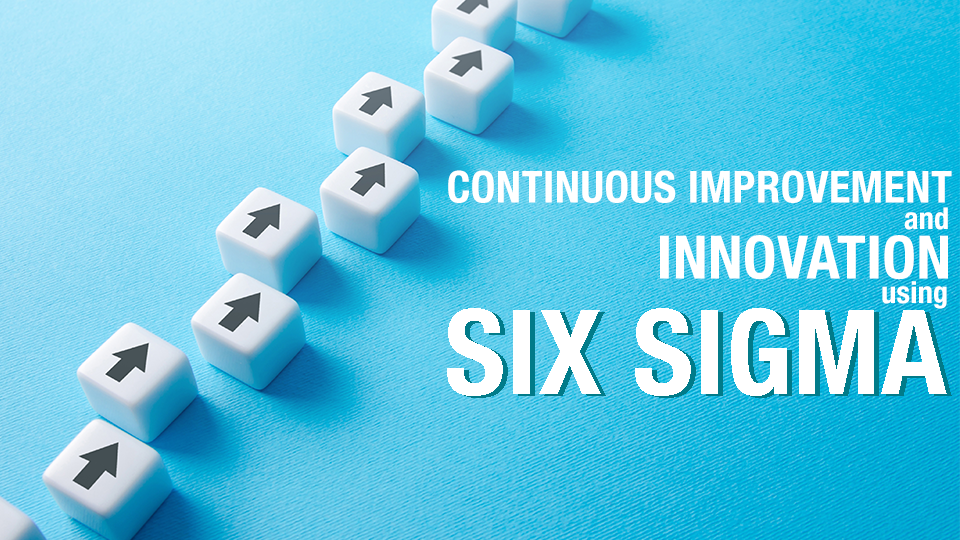Continuous Improvement and Innovation using Six Sigma
Posted by 6sigmastudy® on January 02, 2024 | Quality Management
Keywords: Six Sigma 6sigmastudy Continuous Improvement Six Sigma Yellow Belt (SSYB™) Six Sigma Green Belt (SSGB™) Six Sigma Black Belt (SSBB™) Lean Six Sigma Green Belt (LSSGB™) Lean Six Sigma Black Belt (LSSBB™) Free Articles Free Six Sigma Articles TQM Six sigma define dmaic dmadv
Adapting a culture of continuous improvement and innovation is vital for organizations to succeed. This article outlines six key steps to nurture such a culture, encouraging sustained growth and adaptability. By establishing clear goals, empowering teams, using systematic approaches, engaging customers, learning from mistakes, and encouraging collaboration, organizations can cultivate an environment that promotes innovation. This ensures long-term success in the ever-evolving business world. The steps involved in this context are:
- Define Vision and Goals: The initiation of a culture of continuous improvement commences with the establishment of a clear vision and well-defined goals. Organizations must articulate their aims and set measurable criteria for success. Aligning these objectives with the business strategy and meeting customer needs creates a shared sense of purpose. Effective communication is crucial – regularly and consistently conveying the vision and goals to the team and stakeholders inspires them to actively pursue opportunities for improvement and innovation.
- Empower the Team: Empowering the team is crucial for creating a culture of constant improvement. It involves giving them the freedom, authority, and resources to try new things, learn, and make positive changes. Encouraging open communication for sharing ideas, feedback, and suggestions is important. Providing the tools, training, and support needed for skill development is also key. Recognizing and rewarding their efforts builds trust, engagement, and a sense of ownership. Celebrating successes encourages a mind-set of growth and cultivates a culture of continuous learning.
- Apply a Systematic Approach: Choosing a systematic approach boosts the success of continuous improvement and innovation efforts. By adopting proven methodologies like Lean, Six Sigma, or Agile, organizations guide their projects with structured processes. These processes involve defining the problem, analysing data, generating and testing solutions, implementing and monitoring results, and standardizing and sustaining improvements. Utilizing tools such as process mapping, root cause analysis, brainstorming, prototyping, and feedback loops helps in achieving a comprehensive and effective approach, ensuring quality and efficiency throughout the improvement journey.
- Involve Your Customers: Customers play a central role in a successful business. To improve and innovate, it's crucial to consider what customers need, expect, and prefer. Actively ask for their thoughts, feedback, and ideas to make sure your solutions match their needs. Always provide value and try to go beyond what they expect, aiming to create long-lasting relationships. When customers are involved in the improvement process, it builds loyalty, satisfaction, and advocacy, which positively impacts overall business performance.
- Learn from Failures: In the journey of improvement, acknowledging failure as a vital element is key. Encouraging the team to take calculated risks and perceive failure as an opportunity for growth is essential. Creating an environment that refrains from blaming or punishing mistakes, emphasizing learning from failures is crucial. Experiences and lessons are shared among the team and stakeholders, contributing to the enhancement of processes, products, and services. The cultivation of a culture marked by resilience, adaptability, and curiosity supports the exploration of novel and improved approaches.
- Collaborate and Innovate: Encourage the organization to embrace collaboration as a core element for continual improvement and innovation. Tap into the diverse skills, creativity, and expertise of the team and stakeholders. Establish cross-functional teams, networks, and communities of practice to facilitate knowledge sharing, brainstorming, and collective problem-solving. Explore external partnerships with suppliers, customers, competitors, or industry experts. Utilize platforms like social media, blogs, or podcasts to share success stories, motivating others to join the journey. Foster a culture that values collaboration, innovation, and influence, creating an ecosystem conducive to continuous improvement and innovation.
Building a culture of continuous improvement and innovation needs a comprehensive strategy: clear vision, empowering teams, systematic methods, involving customers, learning from mistakes, and collaborative innovation. These six steps, when applied, create a dynamic environment that adapts to change, welcomes innovation, and consistently improves performance.
For more such interesting articles on Six Sigma and its concepts, please click here

